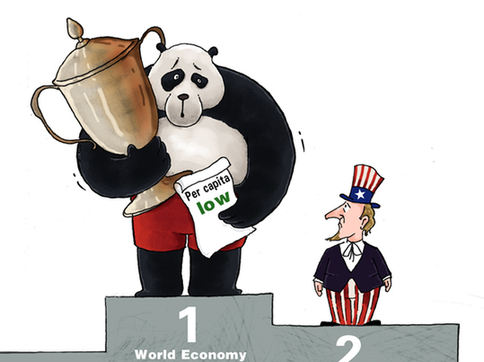One measure means little in China's economy
- By Zhang Lijuan
 0 Comment(s)
0 Comment(s) Print
Print E-mail China.org.cn, November 12, 2014
E-mail China.org.cn, November 12, 2014
There has been debate, although it is decreasing, about whether or not China's GDP will surpass the United States' GDP by the end of this year. In April, the World Bank's International Comparison Program released its estimate that China's economy was 87 percent of the size of the U.S. economy in 2011. Recently, the International Monetary Fund (IMF) came to a similar conclusion: the size of China's economy will surpass the U.S. ($17.63 trillion versus $17.42 trillion) by the end of this year. All of these estimates are based upon the traditional methodology: purchasing power parity (PPP). To many, the use of one measure, GDP, means very little when trying to understand the real China. Here is why.
|
A mixed story [By Zhai Haijun/China.org.cn] |
First of all, the PPP theory itself remains controversial. PPP theory asserts that the exchange rate change between two currencies, for instance the dollar and the renminbi, over any period of time is determined by the change in the two countries' relative price levels. How reliable is the data collected? How freely does the Chinese exchange rate float? And why are products "made in China" cheaper in the United States and more expensive in China? All of these questions puzzle economists. Needless to say, service industries and economic financialization are prominent features of today's economy. Consequently, it is hard to apply PPP methodology to measure the size of the Chinese economy relative to that of the United States.
Secondly, China is not a developed economy by any means. It is not a service economy or a consumer economy. Its agricultural economy remains underdeveloped. China's farm household income is far behind its non-farming household income. In 2013, China's median net per capita income of farmers was 7,907 yuan (about US$1,297, using the official exchange rate at the end of 2013), while its median net non-farming per capita income was 24,200 yuan (about US$3,969). In another words, China's non-farming income was about three times as much as its farming income on a per capita basis. This partially explains why urbanization is not an option for the government, but it is a choice for farmers. According to the Economic Research Service of the U.S. Department of Agriculture, the median total farm household income in the United States exceeded the median household income in every year since 1998. In 2012, the median farm operator household income exceeded median U.S. household income by 33.9 percent (US$68,298 compared to US$51,017). Besides, U.S. agricultural exports have been driving the U.S. economy out of recession during the post-crisis years. Obviously, there can be no meaningful comparison, at this stage, between the two economies' agriculture sectors. But, without a powerful agricultural sector, it is hard to argue that China is real economic power.






